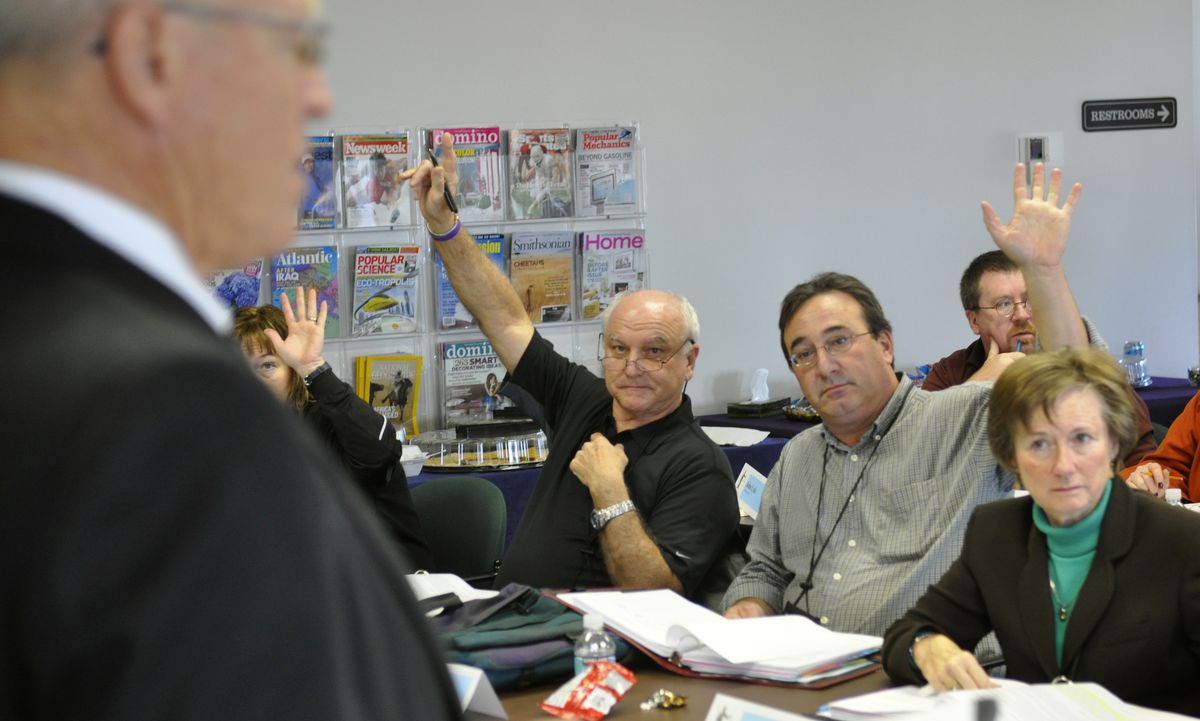Teachers court
Area educators get lessons on federal judicial process

A federal judge became a teacher and 25 teachers got to be the judge, as the first Judicial Institute for High School Teachers convened Thursday.
On the first morning of the two-day event at the U.S. Courthouse in Spokane, the group of Eastern Washington educators tackled two of the toughest issues confronting federal judges: discretion in sentencing and judicial review.
Chief U.S. District Judge Robert Whaley is presiding over the institute.
“The theory is that for reasons of curriculum changes, there isn’t as much being taught about the structure of government, particularly the role of the judiciary,” Whaley said.
He hopes the teachers – who applied for the institute at the invitation of the U.S. District Court for Eastern Washington – will take what they learned back to their students.
That’s exactly what Lori Jacobsen intends to do.
The East Valley High School history and American government teacher said she would use in her classroom some of the sentencing scenarios presented to institute participants Thursday.
In one scenario, designed to reflect immigration cases often heard in Eastern Washington federal courtrooms, two Mexican nationals were sentenced for illegally re-entering the United States. The teachers watched videos of fictitious defendants’ sentencing hearings and then decided what terms to hand down based on sentencing guidelines.
The teachers were given presentencing reports on the defendants, a 35-year-old mother of two who had lived in the United States since she was an infant, and her brother-in-law, a 38-year-old member of a drug cartel who came to the United States to establish a drug distribution network.
The teachers, relying on their judgment rather than strict adherence to the guidelines, gave the brother-in-law more prison time than the mother.
“How does our society benefit by putting her children in foster homes?” Jacobsen asked.
It was the response Whaley was looking for. One of the most difficult things to explain to people is judicial discretion in sentencing, the judge said.
“Most people think you should be hard on crime, without dealing with individual circumstances,” he said.
Earlier, Whaley lectured the teachers on a controversial topic: judicial restraint vs. judicial activism.
On the one hand, conservative legal scholars, such as Supreme Court Justice Antonin Scalia, advocate “originalism” in constitutional interpretation, Whaley said. Others contend the U.S. Constitution is a living document that should grow and evolve.
“Our Constitution created a government that had never been seen before,” Whaley told the teachers, and “the great changes in society sprang from how the Constitution was interpreted.”
The 14th Amendment, ratified in 1868, guaranteed U.S. citizens due process and equal protection under the law, Whaley said, but “the meaning of those clauses was not self-evident.” It had to be interpreted by judges.
Desegregation, the right to privacy and the right to legal counsel were all interpretations of the Constitution that represented “the evolution of thinking in our society,” Whaley said.
The discussion was just what Brian Kissinger was hoping for when he applied to attend the institute.
Kissinger, who teaches American studies at Rogers High School in Spokane, said he had learned “a way of explaining to the kids the whole concept of judicial review.”
Today’s sessions will include a discussion of the role of the judiciary by 9th U.S. Circuit Court of Appeals Judge Richard Tallman.
Whaley said he hopes the institute will continue. It is financed through a discretionary fund supported by fees lawyers pay to practice in U.S. District Court for Eastern Washington.
“We’re hoping that if it is liked, we can do it every two or three years,” the judge said.